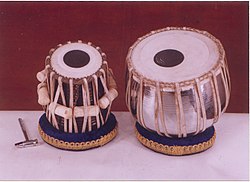
Back طبلة Arabic তবলা Assamese तबला AWA Табла (музикален инструмент) Bulgarian तबला Bihari তবলা Bengali/Bangla Tabla Catalan Tabla Czech Tabla Danish Tabla German
 | |
| Percussion instrument | |
|---|---|
| Classification | Membranophone percussion instrument |
| Hornbostel–Sachs classification | 211.12 (Sets of instruments in which the body of the drum is dish- or bowl-shaped) |
| Developed | 18th century, North India (modern tabla) |
| Playing range | |
| One octave (variable)[1][2] | |
| Related instruments | |
| Pakhavaj, mridangam, khol, dholak, nagara, madal, tbilat, jori, bongos | |
A tabla[nb 1] is a pair of hand drums from the Indian subcontinent. Since the 18th century, it has been the principal percussion instrument in Hindustani classical music,[3] where it may be played solo, as an accompaniment with other instruments and vocals, or as a part of larger ensembles. It is frequently played in popular and folk music performances in India, Bangladesh, Afghanistan, Pakistan, Nepal and Sri Lanka.[4][5] The tabla is an essential instrument in the bhakti devotional traditions of Hinduism and Sikhism, such as during bhajan and kirtan singing.[6][7] It is one of the main qawwali instruments used by Sufi musicians.[8] The instrument is also featured in dance performances such as Kathak. Tabla is a rhythmic instrument. [9]
The name tabla likely comes from tabl, the Arabic word for drum.[10] The ultimate origin of the musical instrument is contested by scholars, though some trace its evolution from indigenous musical instruments of the Indian subcontinent.[11]
The tabla consists of two small drums of slightly different sizes and shapes.[4][12] Each drum is made of hollowed-out wood, clay or metal. The smaller drum (dayan/tabla) is used for creating treble and tonal sounds, while the primary function of the larger drum (baya/dagga) is for producing bass. They are laced with hoops, thongs and wooden dowels on its sides. The dowels and hoops are used to tighten the tension of the membranes for tuning the drums.[13]
The playing technique is complex and involves extensive use of the fingers and palms in various configurations to create a wide variety of different sounds and rhythms, reflected in mnemonic syllables (bol).
- ^ Abram, David (1994). India: The Rough Guide. Rough Guides. p. 1137. ISBN 978-1-85828-104-9.
- ^ Ellingham, Mark (1999). The Rough Guide to World Music. Rough Guides. p. 73. ISBN 978-1-85828-636-5.
- ^ Don Michael Randel (2003). The Harvard Dictionary of Music. Harvard University Press. pp. 820, 864. ISBN 978-0-674-01163-2.
- ^ a b Tabla Encyclopædia Britannica
- ^ Baily, John (1988). Music of Afghanistan : professional musicians in the city of Herat. Cambridgeshire [England]: Cambridge University Press. ISBN 0-521-25000-5. OCLC 17299692.
- ^ Denise Cush; Catherine Robinson; Michael York (2012). Encyclopedia of Hinduism. Routledge. pp. 87–88. ISBN 978-1-135-18978-5.
- ^ Derek B. Scott (2009). The Ashgate Research Companion to Popular Musicology. Ashgate Publishing. p. 289. ISBN 978-0-7546-6476-5.
- ^ Kamal Salhi (2013). Music, Culture and Identity in the Muslim World: Performance, Politics and Piety. Routledge. pp. 183–184. ISBN 978-1-317-96310-3.
- ^ Nettl, Bruno; Stone, Ruth M.; Porter, James; Rice, Timothy (eds.). The Garland encyclopedia of world music. New York. ISBN 0-8240-6035-0. OCLC 36407898.
- ^ Richard Emmert; Yuki Minegishi (1980). Musical voices of Asia: report of (Asian Traditional Performing Arts 1978). Heibonsha. p. 266. Retrieved 25 December 2012.
- ^ Cite error: The named reference
Gottlieb1993p1was invoked but never defined (see the help page). - ^ William Alves (2013). Music of the Peoples of the World. Cengage Learning. p. 252. ISBN 978-1-133-30794-5.
- ^ Neil Sorrell; Ram Narayan (1980). Indian Music in Performance: A Practical Introduction. Manchester University Press. pp. 40–41. ISBN 978-0-7190-0756-9.
Cite error: There are <ref group=nb> tags on this page, but the references will not show without a {{reflist|group=nb}} template (see the help page).
© MMXXIII Rich X Search. We shall prevail. All rights reserved. Rich X Search